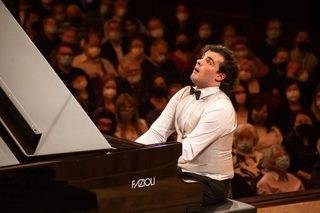|
Back
Transcendent Power New York
Merkin Hall at Kaufman Music Center
07/10/2023 -
Frédéric Chopin: Mazurkas, Opus 33 – Barcarolle in F‑Sharp Minor, Opus 60 – Preludes, Opus 28 No. 13, 3, 2 & 14 – Sonata No. 2 in B‑flat minor, Opus 35
Franz Liszt: Années de pèlerinage (Deuxième Année : Italie), S. 161: 1. « Sposalizio » – Sonata in B minor, S. 178
Martín García García (Pianist)

M. García García (© Darek Golik)
“Chopin, the most ethereal, subtle, and delicate among our modern tone-poets. It is a rare thing for a great artist to stand patiently and hold aloft the blazing torch of his own genius, to illume the gloomy grave of another: yet this has Liszt done through love for Chopin.”
Franz Liszt, Life of Chopin
“Simplicity is everything...no noises, no effects, just simplicity, as in all that is beautiful.”
Frédéric Chopin (to his students)
First, I had no desire to stay for what was certainly going to be an encore of Martín García García’s skills. After his performance of Liszt’s B Minor Sonata, Mr. García García’s towering emotional power said what had to be said.
Any further piano-playing would be dross on the gold.
Second, this is a pianist who belies his youth, especially in the two Liszt works of the second half. Most pianists of his age would thunder through the music, their gifts wrapped up in the gaudiest covering. Mr. García García was hardly averse to thunder and lightening–when necessary. Yet when it came to the utter the breathless beauty of “The Breath” or the post-Beethoven majesty, tragedy and triumph of the Sonata, this pianist was closer to a Richter than a Trifonov.
Then again, Mr. García García already has an admirable history. First Prize-winner at the Cleveland International Piano Competition, Third Prize winner at the most prestigious Chopin Piano Competition, he has already performed with the great orchestras of Europe, was invited to play at the Martha Argerich festival and continues with his own compositions, as well as his native Spanish composers.
Nor was it a coincidence that the International Keyboard Institute and Festival invited him this year. After all, the distinguished pianist Jerome Rose is not only a director of the Festival–but was Mr. García García’s teacher at Mannes College.
His repertory is wide enough. But here he confined himself to Chopin (the first half) and Liszt, excelling at both.
The Chopin selections were played with both intensity and decorum. The four Mazurka selections were emotionally the most difficult. How could Chopin have possibly framed his most exquisite pictures in the frame of a 16th Century dance? The originality, the pictures (the dreams?) and the emotions were wildly diverse. Mr. García García didn’t go off the rails with the wild Second Mazurka, and was decorous enough with the others. No excessive rubato, always control. He did give a most personal style to the Third Mazurka. This was a conversation between treble and bass–and we could eavesdrop on the fascinating colloquy.
The Barcarolle was played as a beautiful abstraction. I never once caught the gondolier’s song, but Chopin was enough. The four Preludes were a joy. Mr. García García understood the romantic cantabile of the 13th and 2nd and played the running left hand of the 3rd with felicitous exactness.
Yet his real challenge came in the Second Sonata. Mr. García García García’s technical dexterity came with that enigmatic minute-long frenzied finale. Before that, he was neither violent nor melodramatic. (The melodrama was left for the Liszt.) One hardly looks for contentment here, but one certainly appreciated Mr. García García’s clarity, his limpid artistry.
One assumes that any pianist worth his chops would approach the Funeral March with the same care as Olivier or Gielgud approaching “To be or not to be.” Ignore the axiomatic familiarity. Both the movement and the monologue tell–in notes and poetry–the enigmas of death.
Mr. García García didn’t attempt an idiosyncratic Marche funèbre. The notes can speak for themselves. The first theme was respectful, never lugubrious. That second theme was less a contrast then a complement to the first, the tribute of a single flower on the tombstone.
The pianist’s pictures of Chopin were welcoming. His huge frescos, his magnificent Renaissance tapestries of Liszt were–if never jolting–always electrifying. The opening “Sposalizio,” had it been written by Chopin, would have been a felicitous bagatelle. Mr. García García gave the multi-layered Liszt the utmost in feeling, with a variety of breadths. From the opening quiet procession to the fortissimo climax, this was as much painting as music.
As to the B Minor Sonata, I was stunned. Under his hands, one heard not so much the reputed “transformation of themes” or demonic changes of movements. Rather, Mr. García García eliminated the opaque “meaning” to present a gorgeous, literally mesmerizing architectural monument, a creation far far beyond his years, and, under his hands, a vivid masterpiece.
Harry Rolnick
|